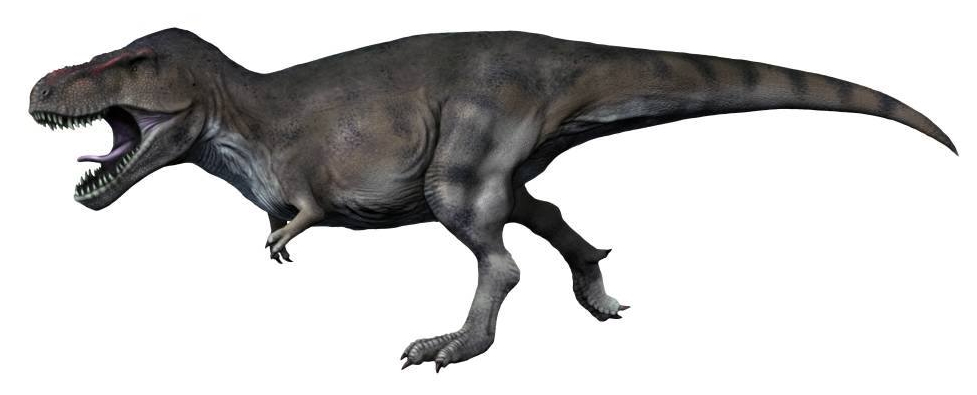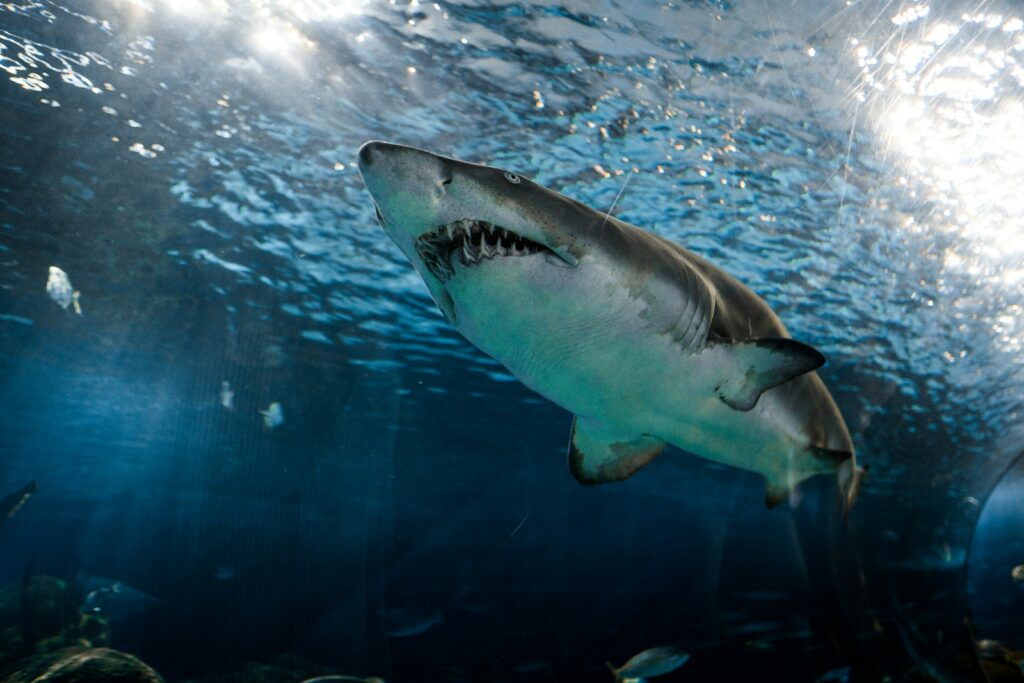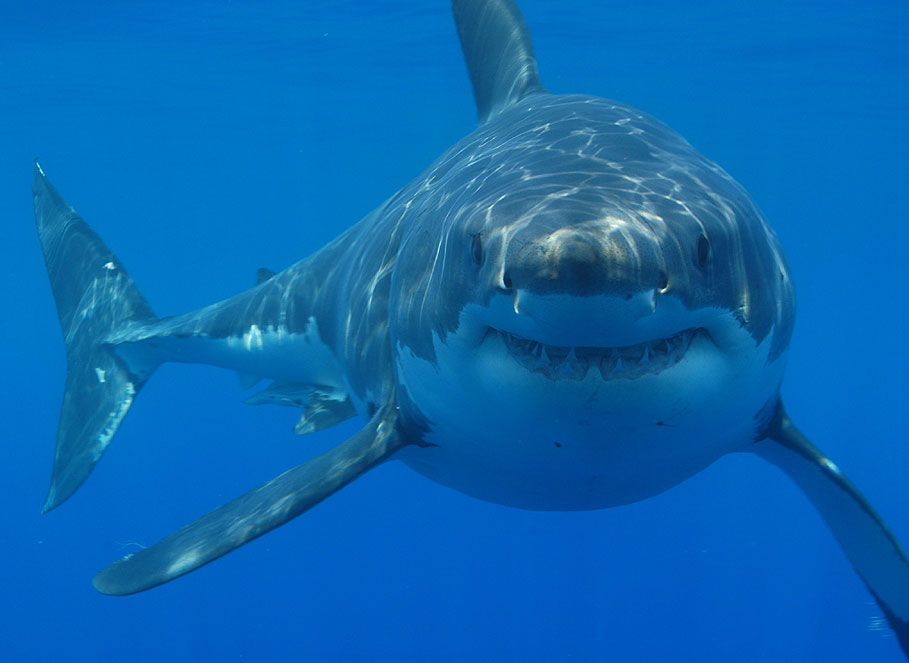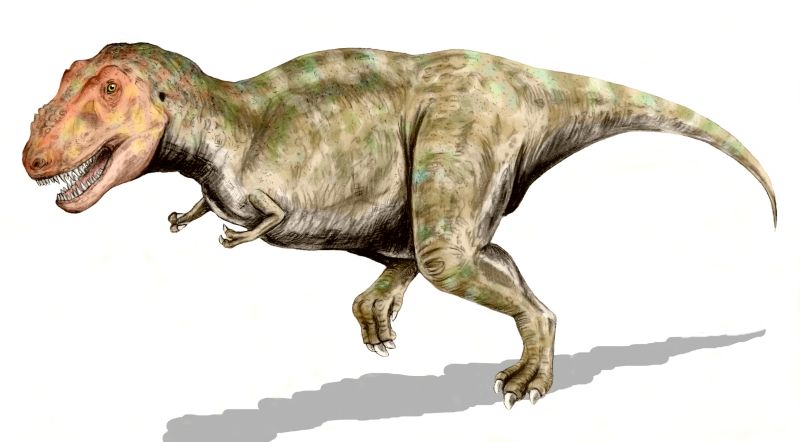In the realm of apex predators, few creatures capture our imagination quite like the Tyrannosaurus rex and the Great White shark. These magnificent hunters, separated by millions of years of evolution and vastly different environments, represent the pinnacle of predatory adaptation in their respective domains. The T-rex, the “tyrant lizard king,” dominated the terrestrial ecosystems of the Late Cretaceous period, while the Great White shark has earned its reputation as the ocean’s most formidable hunter over millions of years. This fascinating comparison explores how these apex predators stack up against each other across various dimensions, examining their hunting prowess, physical adaptations, and ecological impacts to determine which truly reigns supreme in the annals of predatory excellence.
The Evolutionary Context

Tyrannosaurus rex and Great White sharks represent evolutionary success stories from vastly different eras and environments. T-rex roamed North America during the Late Cretaceous period, approximately 68-66 million years ago, representing the culmination of theropod dinosaur evolution. Great White sharks, meanwhile, belong to a lineage that has survived for over 400 million years, with the modern species (Carcharodon carcharias) evolving approximately 16 million years ago during the Middle Miocene epoch. These temporal differences highlight an important distinction: while T-rex became extinct alongside other non-avian dinosaurs during the Cretaceous-Paleogene extinction event, the Great White’s ancestors survived multiple mass extinctions, demonstrating remarkable evolutionary resilience. This survival through geological time gives the shark an edge in evolutionary success, having adapted to changing ocean conditions while the mighty T-rex’s reign lasted only a few million years before complete extinction.
Physical Dimensions and Mass

When comparing pure size, the Tyrannosaurus rex dwarfs the Great White shark in most dimensions. Fossil evidence indicates that T-rex could reach lengths of 40-43 feet (12-13 meters) and heights of up to 20 feet (6 meters) when standing upright. Adult specimens likely weighed between 5.5 and 9 tons (5,000-8,000 kg), with some estimates suggesting certain individuals may have exceeded 10 tons. In contrast, Great White sharks typically grow to 15-16 feet (4.6-4.9 meters) in length, with exceptional females occasionally reaching 20 feet (6 meters). The largest reliably measured Great Whites weigh approximately 2.5 tons (2,300 kg), though larger unverified specimens have been reported. This substantial size difference would seemingly give T-rex a clear advantage in any theoretical confrontation, though it’s worth noting that the shark’s streamlined, hydrodynamic body represents a different but equally effective evolutionary strategy for its marine environment.
Bite Force and Dental Weaponry

Both predators possessed devastating bite capabilities, though research suggests the T-rex had the most powerful bite of any terrestrial animal that ever lived. Scientific estimates place T-rex’s bite force between 35,000 and 57,000 newtons at its back teeth, with some studies suggesting it could exert up to 64,000 newtons of force. Its teeth, measuring up to 12 inches long including the root, were serrated like steak knives and designed to crush bone and tear flesh. Great White sharks, while not matching these extreme forces, still deliver an impressive bite estimated at 18,000 newtons. The shark compensates with a unique dental strategy: rows of triangular, serrated teeth that continuously regenerate throughout its lifetime, with individuals potentially growing and shedding over 20,000 teeth during their lives. While T-rex possessed the stronger bite in absolute terms, the shark’s perpetually renewing dentition represents a remarkable adaptation that allowed for continuous predatory effectiveness without the vulnerability of permanent tooth damage.
Sensory Capabilities

In terms of sensory adaptations, the Great White shark demonstrates remarkable evolutionary specialization that likely surpasses the T-rex. Sharks possess an extraordinary suite of senses, including the ability to detect electromagnetic fields through specialized organs called ampullae of Lorenzini, allowing them to sense the electrical impulses of prey’s heartbeats from considerable distances. Their olfactory capabilities are legendary, with the ability to detect blood in concentrations as low as one part per million. Great Whites can also sense vibrations in the water through their lateral line system and specialized hearing adaptations. By comparison, T. rex likely relied primarily on vision and smell. Recent research suggests T-rex had exceptional binocular vision, with visual acuity potentially exceeding that of modern hawks and the ability to see objects up to 6 kilometers away. Its olfactory bulbs were also large, indicating a well-developed sense of smell. However, the shark’s multi-sensory hunting apparatus, evolved specifically for detecting prey in the three-dimensional marine environment, represents a more sophisticated sensory arsenal overall.
Hunting Strategies and Techniques

The hunting approaches of these apex predators reflect their adaptation to fundamentally different environments. T-rex likely employed a combination of ambush and pursuit tactics, using its acute vision to spot prey and its surprising speed to close distances quickly. Biomechanical studies suggest adult T-rexes could move at speeds of 10-25 mph (16-40 km/h), impressive for an animal of its size. The dinosaur’s massive jaws and bone-crushing bite allowed it to dispatch even large prey efficiently. Great White sharks, meanwhile, have developed a specialized hunting technique that capitalizes on stealth and explosive power. When hunting seals and sea lions, they often patrol beneath their prey, using counter-shading camouflage to remain hidden before launching a vertical ambush attack at speeds approaching 35 mph (56 km/h). This initial strike is typically followed by a retreat as the shark waits for the prey to bleed out before returning to feed. The shark’s strategy demonstrates remarkable efficiency, minimizing risk while maximizing energy conservation—a critical factor in the open ocean environment where prey encounters may be infrequent.
Metabolic Demands and Energy Efficiency

The metabolic requirements of these predators reveal significant differences in their energy management strategies. T-rex, as an endothermic (warm-blooded) dinosaur, would have required substantial caloric intake to maintain its body temperature and fuel its massive musculature. Conservative estimates suggest an adult. Rex may have consumed 400-600 pounds of meat in a single feeding, potentially requiring several days between large meals. The Great White shark, by contrast, exhibits regional endothermy—maintaining elevated temperatures in certain body parts while allowing others to fluctuate with the surrounding water. This adaptation allows the shark to operate efficiently in cold waters while conserving energy. Great Whites can survive on surprisingly infrequent meals, with some individuals going weeks between significant feedings. After consuming a large seal (approximately 100 pounds), a Great White might not need to feed again for 1-2 weeks. This metabolic flexibility gives the shark a survival advantage, especially in environments where prey availability fluctuates seasonally.
Reproductive Strategies

The reproductive approaches of these apex predators highlight dramatic evolutionary differences. T-rex, like other dinosaurs, laid eggs, though no definitive T-rex eggs have been discovered. Paleontologists believe female T-rexes may have laid clutches of 12-20 eggs, with relatively few surviving to adulthood, given the harsh Cretaceous environment. Great White sharks employ an entirely different reproductive strategy called aplacental viviparity, where eggs develop and hatch inside the mother’s body. After an exceptionally long gestation period of 12-18 months, females give birth to 2-10 fully formed pups measuring 4-5 feet in length. These pups are immediately independent and capable of hunting small prey. Perhaps most remarkably, evidence suggests Great White embryos engage in oophagy—consuming unfertilized eggs within the uterus—and even embryonic cannibalism, where stronger embryos consume their siblings. This “survival of the fittest” begins before birth, ensuring only the most competitive individuals enter the ocean ecosystem.
Longevity and Life History

The lifespan and growth patterns of these predators reveal contrasting life history strategies. Based on bone histology studies, scientists estimate. rexrex reached adult size in approximately 20 years, experiencing a dramatic growth spurt during adolescence when it gained up to 4.6 pounds (2.1 kg) daily. The maximum life span T-rex is believed to have been 28-30 years old, with few individuals reaching full maturity in the challenging Late Cretaceous environment. Great White sharks demonstrate remarkably different life history characteristics, with individuals potentially living 70+ years according to recent aging studies using radiocarbon dating of vertebrae. Their growth is slower but more sustained, with females continuing to grow throughout their lives, potentially reaching larger sizes with advancing age. Sexual maturity occurs relatively late, with males maturing at 26 years and females around 33 years. This extended lifespan and delayed reproduction represent an evolutionary strategy favoring long-term survival and reproductive success over many decades, contrasting sharply with the faster-paced life cycle of T. rex.
Environmental Adaptability

When examining environmental adaptability, the Great White shark demonstrates remarkable versatility compared to T-rex’s more specialized existence. Great Whites inhabit temperate and subtropical waters worldwide, from surface waters down to depths exceeding 3,900 feet (1,200 meters). They routinely navigate between different temperature zones, tolerating water temperatures from 54-75°F (12-24°C), with regional endothermy allowing them to maintain critical body parts at higher temperatures than the surrounding water. Some populations undertake vast migrations spanning thousands of miles, such as the documented routes between Australia and South Africa. T-rex, by contrast, was restricted to the island continent of Laramidia (western North America) during the Late Cretaceous, thriving in the warm, humid, semi-tropical environments that characterized this period. The dinosaur’s specific habitat requirements and limited geographic distribution suggest less environmental adaptability than the globally distributed shark, which has survived fluctuating ocean conditions, including multiple ice ages and warming periods, over millions of years.
Ecological Role and Impact

Both predators served as keystone species in their respective ecosystems, but with significantly different ecological footprints. T-rex occupied the apex predator niche in the Late Cretaceous terrestrial ecosystems of North America, potentially influencing the evolution, behavior, and population dynamics of contemporary herbivorous dinosaurs like Triceratops and Edmontosaurus. By controlling the herbivore population. Rex-rex would have indirectly influenced vegetation patterns and ecosystem structure. Great White sharks fulfill a similarly crucial role in marine ecosystems, but their impact extends across multiple trophic levels. Beyond controlling seal and sea lion populations, they influence the behavior of other marine predators through competitive interactions and risk effects. Through scavenging behavior, they also contribute to nutrient cycling in marine environments. Perhaps most significantly, their predation on weaker or diseased individuals helps maintain the genetic health of prey populations—an ecosystem service that extends beyond simple population control. The shark’s broader ecological influence across diverse marine ecosystems arguably represents a more extensive ecological impact than the geographically limited T-rex.
Intelligence and Learning Capacity

Cognitive capabilities represent another fascinating dimension for comparison between these predators. T-rex possessed a brain weighing approximately 400 grams, substantial in absolute terms but relatively small compared to its body mass. Its encephalization quotient (a measure of relative brain size) was modest compared to modern predators, though still higher than many other dinosaurs. Paleontological evidence suggest T-rex had enlarged olfactory lobes and optic lobes, indicating specialization in sensory processing rather than advanced cognition. Great White sharks have often been mischaracterized as simple “eating machines,” but recent research challenges this perception. Their brain-to-body mass ratio exceeds that of many fish species, with particularly developed areas for sensory processing. Studies of captive sharks demonstrate their capacity for social learning, problem-solving, and even curiosity-driven behavior. Field observations reveal complex decision-making during hunting, with individuals abandoning attacks when risks outweigh potential rewards, suggesting a sophisticated risk assessment capacity. While neither animal approaches mammalian intelligence, the shark’s demonstrated learning abilities likely surpass the cognitive capabilities that could be reasonably attributed toT. Rexx is based on current evidence.
Cultural Impact and Human Fascination

Both predators have exerted an outsized influence on human culture and imagination, though in distinctly different ways. rexex has dominated paleontological popular culture since its discovery in 1905, becoming the most recognizable dinosaur in history. Its imposing presence has been featured in countless books, films, and exhibitions, from the groundbreaking stop-motion animation in the original King Kong (1933) to its starring role in Jurassic Park (1993). The Great White shark achieved similar cultural prominence primarily through Peter Benchley’s novel “Jaws” and Steven Spielberg’s 1975 film adaptation, which permanently altered public perception of sharks and created what marine biologists now call the “Jaws effect”—an exaggerated fear of shark attacks that persists despite their statistical rarity. While T-rex is generally portrayed with a sense of awe and fascination, the Great White has often been depicted as a villain or monster, though recent documentaries and conservation efforts have worked to rehabilitate its image. Both creatures tap into primal human fears and fascination with apex predators, though the living Great White serves as a more immediate reminder of nature’s power in the modern world.
Conservation Status and Survival Prospects

The stark contrast in these predators’ current status—one extinct for 66 million years, the other struggling for survival—offers a final compelling point of comparison. T-rex disappeared along with all non-avian dinosaurs during the Cretaceous-Paleogene extinction event, likely triggered by an asteroid impact combined with volcanic activity. This catastrophic event eliminated approximately 75% of all species on Earth, demonstrating that even the most perfectly adapted apex predator remains vulnerable to global environmental changes. Great White sharks, despite their evolutionary success spanning millions of years, now face unprecedented threats from human activities. Currently classified as “Vulnerable” on the IUCN Red List, Great White populations have declined substantially due to commercial fishing, bycatch, habitat degradation, and targeted killing. Climate change poses additional challenges, potentially altering prey distribution and ocean chemistry. Despite international protections, illegal fishing continues to threaten remaining populations. The Great White’s current predicament highlights a sobering reality: while this magnificent predator survived multiple natural extinction events over millions of years, human activities may accomplish in decades what nature failed to do over geological time scales.
Conclusion: The Ultimate Apex Predator

When evaluating which apex predator truly reigns supreme, we must acknowledge that rexrex and the Great White shark represent evolutionary perfection, adapted to completely different environments and eras. T. rex dominated its terrestrial ecosystem with unmatched bite force, massive size, and formidable hunting prowess. However, the Great White shark demonstrates remarkable evolutionary resilience, sophisticated sensory adaptations, and global distribution that have allowed it to survive and thrive across millions of years, while T-rex’s reign was relatively brief. Rather than crowning a single champion, perhaps the most profound insight comes from recognizing how these magnificent predators illuminate different pathways to apex status—one through overwhelming power and specialization, the other through adaptability and evolutionary persistence. While the T-rex remains frozen in time as a perfect snapshot of prehistoric predatory excellence, the Great White continues its evolutionary journey in our oceans, facing its greatest challenge not from natural competitors but from human activities that threaten its continued existence.




